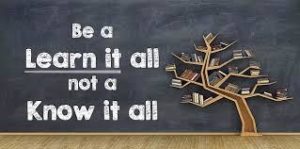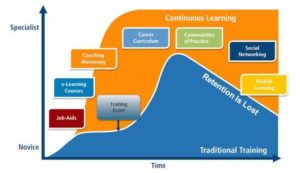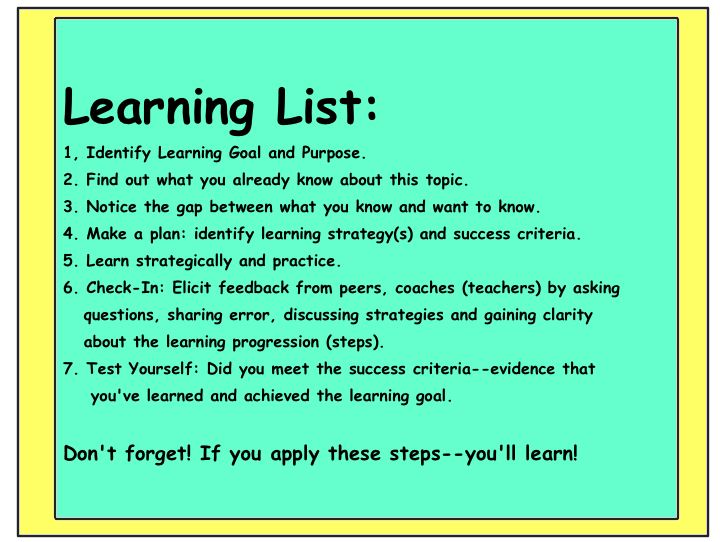
April 14, 2021
In the digital world,
learn-it-all beats know-it-all

Are you learning faster than your competition?
Several years ago, the leaders of the Gates Foundation embarked on a journey to improve their culture. Their goal was “to improve their learning culture, in which people have the humility to know what they don’t know and the curiosity to rethink the way they’ve always done things.”
When Satya Nadella took over as CEO of Microsoft in 2014, he said “we are going to be a learn-it-all company rather than a know-it-all one.”
Warren Buffet has invested 80% of his time in reading and learning throughout his career. He said the key to his success was to “read 500 pages every day. That’s how knowledge works. It builds up like compound interest.” His long-time business partner, Charlie Munger, said “without Warren Buffet being a learning machine, the Berkshire Hathaway investing record would have been absolutely impossible.”
In order to successfully compete in the digital world, you have to enable your employees to adapt and iteratively learn at the speed of disruptive technology change. Individual and team adaptation and the ability to continuously create, innovate, and iteratively learn is the primary source of sustainable competitive advantage. Simply put, if you and your organization do not stay at the forefront of this learning curve, your competitive viability is at risk.
Building a culture of continuous learning at work

Most companies’ traditional training and development programs focus on improving their employees technical and functional skills and capabilities. They also create leadership development programs that identify high potential managers who can become the company’s future leaders.
These programs include everything from:
- The company’s values and code of conduct
- Leadership skills and capabilities assessment (e.g. Myers Briggs)
- University base development program
- Offsite leadership team development exercise
- Job rotations
While these programs can generate some short term gains, they are not able to keep up with the current pace of change from disruptive technologies. The shelf life of learning is getting shorter and shorter every year.
To stay at the forefront of this new continuous learning curve requires new skills and capabilities. Below is a chart from the World Economic Forum that highlights their top 10 skills for 2025:

What caught my attention was the top 5 skills all require a degree of continuous learning to do them well.
Execution speed vs. learning speed

Speed-to-market and time-to-value are critical success factors for any company that wants to compete as a digital enterprise. But speed alone is not a source of sustainable competitive advantage.
Michael Simmons has an unbridled passion for teaching people how to learn. His recent research has focused on the difference between execution speed and learning speed and serves to validate the critical differences and benefits between the two. Here is a summary of his comparisons:
“Execution speed is about getting more done by either putting in more resources or by operating more efficiently.” His examples of execution speed include:
- Working a longer day
- Making decisions faster
- Finding a tool that helps you work faster
- Making sure people aren’t waiting on one another to move forward
- Removing a bottleneck in an assembly line
Learning speed has two major differences from execution speed:
- “Higher leverage. You can get 10x return on your learning speed through compounding and better learning techniques. At most, you can get 2x return on how many hours you work.”
- “Fewer sacrifices. When you work too long, you sacrifice your health and relationships with friends and family.”
Here are some of his examples of how you can increase your learning speed:
- Spending more time learning
- Learning knowledge that doesn’t become outdated so your knowledge compounds
- Finding breakthrough knowledge in a sea of info overwhelm
- Creating an experimentation engine so you can rapidly try new ideas
- Systematically identifying and removing your blind spots
I think the major takeaway from Michael’s recent work is that while execution speed is important it is nowhere near as sustainable as learning speed.
Getting started: Create a “to learn” list for your company

To develop a culture of continuous learning, start by drafting, iterating, and re-drafting your company’s “to learn” list. What are the most important things you want to learn that will have the biggest impact on the competitive performance of your organization? Here are some examples to get you started:
- What digital technologies can our company use for increased competitive advantage?
- How much do we know about these digital technologies?
- What areas of our business are most vulnerable to digital disruption?
- What do we need to know to defend ourselves against these disruptions?
- What customer and market data do we need to make informed decisions?
- Do we know how to effectively and efficiently translate data into action?
- What skills and capabilities do we need to compete as a digital enterprise?
- Do we know how to acquire or develop those skills and capabilities?
Learning faster than your competition is the only sustainable competitive advantage. It requires a total commitment to building a culture of continuous learning, rewarding those who exhibit humility about what they do not know and who display unbridled curiosity and passion for learning new ways to get things done.
As always, I am interested in your comments, feedback and perspectives on the ideas put forth in this blog. Please e-mail them to me at here. And, if this content could be useful to someone you know please share it here:


